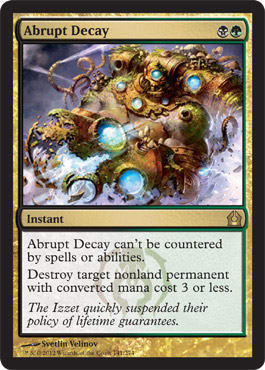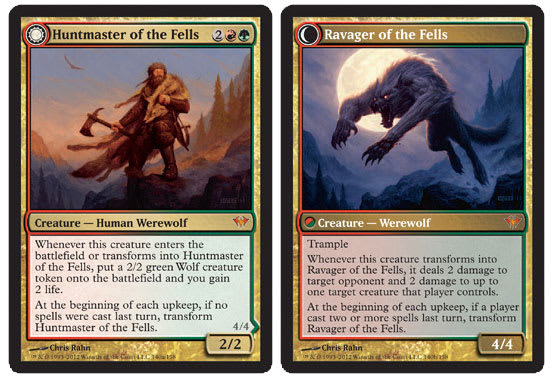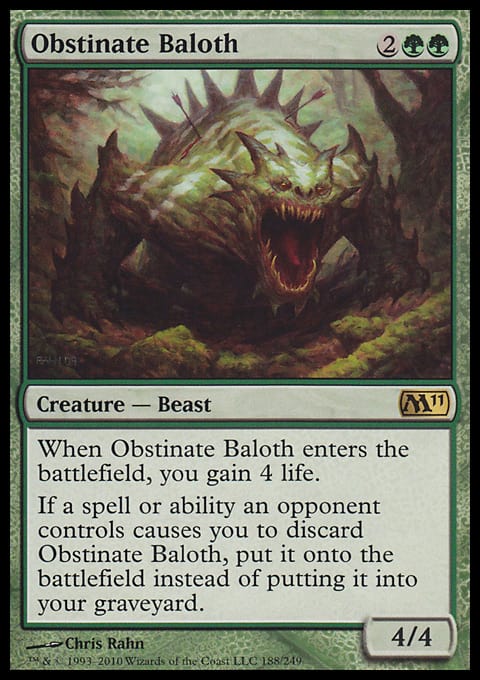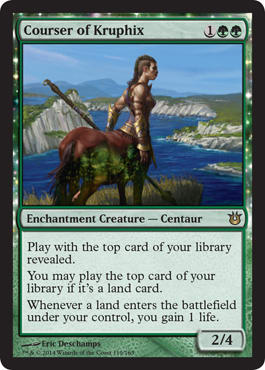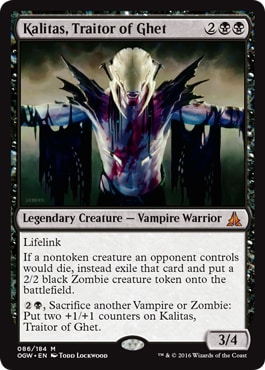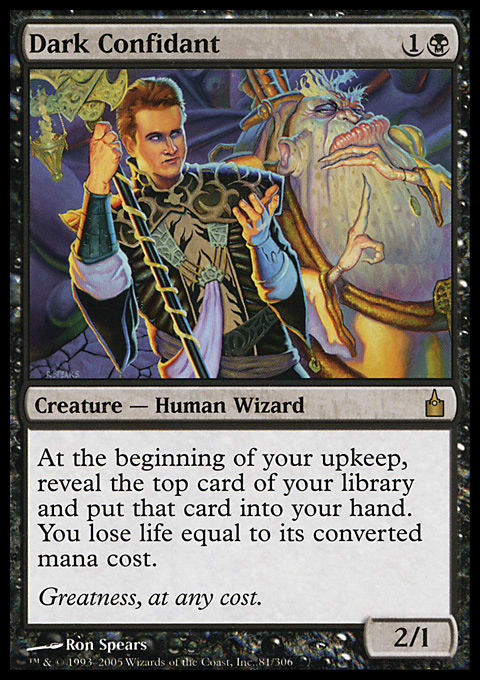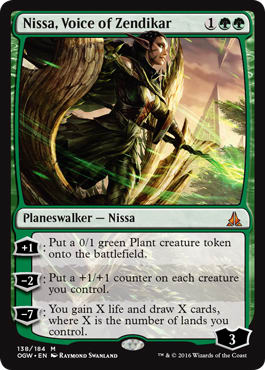“It’s fifty-five percent against everything post-’board!” they said. “If nothing feels good, just play Jund,” rang in the back of my head for the last two weeks as I prepared for the Star City Games Tour’s stop in Milwaukee.
Despite having a reasonable amount of success with Abzan on a local level, the deck plays very differently from Jund. Jund’s spells tend to be less powerful on their own while being more versatile. Abzan leans toward the more powerful end of the spectrum but has a higher curve and a set of drawbacks that come from the slew of powerful spells.
One of the most important parts of having a successful tournament with Jund is having an up-to-date list. I was put into contact with Brian Huffman (winner of the most recent SCG Open in Charlotte), and he gave me a slew of input on the deck. He was an absolutely integral part of my success (more on my definition of success later), and I am incredibly grateful for the insight he provided.
The initial list he sent me as a starting point was the same list that he made the Top 4 of States with during the weekend previous:
Jund ? Modern | Brian Huffman, Top 4, West Virginia States
- Creatures (14)
- 1 Grim Lavamancer
- 3 Scavenging Ooze
- 4 Dark Confidant
- 4 Tarmogoyf
- 2 Kalitas, Traitor of Ghet
- Planeswalkers (3)
- 3 Liliana of the Veil
- Spells (19)
- 2 Kolaghan's Command
- 3 Abrupt Decay
- 3 Terminate
- 4 Lightning Bolt
- 1 Maelstrom Pulse
- 2 Thoughtseize
- 4 Inquisition of Kozilek
- Lands (24)
- 2 Forest
- 2 Swamp
- 1 Blood Crypt
- 1 Ghost Quarter
- 1 Stomping Ground
- 2 Bloodstained Mire
- 2 Overgrown Tomb
- 2 Wooded Foothills
- 3 Raging Ravine
- 4 Blackcleave Cliffs
- 4 Verdant Catacombs
This list appealed very much to me and seemed incredibly refined. The biggest things that stick out on paper are the trimming of a Raging Ravine, the pair of main-decked Kalitas, Traitor of Ghet, and Huffman’s choice to move back to three Abrupt Decays.
With Eldrazi on the decline, Abrupt Decay wasn’t ending up stranded in hand anymore and had a wide range of targets. Having the ability to destroy Liliana of the Veil, Tarmogoyf, Thopter Foundry, and Blood Moon is unbelievable.
The trimming of a Raging Ravine was the first thing I asked Huffman about in our group chat (With Dalton Ozmun). In my experience against Jund, the deck wanted to grind its opponent down to zero cards (even if it meant putting the Jund player down to zero cards as well) and to actually close the game out with Raging Ravine.
Having a Ravine that can attack once without dying quickly snowballs into an enormous threat that is hard to deal with. After one successful attack, the creature land is out of Lightning Bolt range. The next attack, it is bigger than Tasigur, the Golden Fang and the average Tarmogoyf (4/5 due to an instant, a creature, a land, and a sorcery). This continues to get more and more out of hand until the opponent dies—all from an innocuous and painless land.
Huffman quickly agreed with the importance of Raging Ravine in the deck, but he noted that it was rare the Jund deck wanted to draw too many lands that entered the battlefield tapped, and Raging Ravine would have trouble casting some of the deck’s most important discard spells.
The power of Kalitas, Traitor of Ghet in this archetype cannot be understated. It is incredibly difficult to lose a game during which you are able to untap with the legendary Vampire. In a deck with a pile of removal that is generally favored in long games, having a creature that can gain life and produce free virtual cards in the form of 2/2 Zombies is a fantastic asset to have access to.
After a few hours of discussion with Brian and some time alone on an airplane, I arrived at the following list:
Jund ? Modern | Emma Handy, SCG Open Milwaukee, 179th Place
- Creatures (14)
- 1 Grim Lavamancer
- 1 Huntmaster of the Fells
- 3 Scavenging Ooze
- 4 Dark Confidant
- 4 Tarmogoyf
- 1 Kalitas, Traitor of Ghet
- Planeswalkers (3)
- 3 Liliana of the Veil
- Spells (19)
- 2 Kolaghan's Command
- 3 Abrupt Decay
- 3 Terminate
- 4 Lightning Bolt
- 1 Maelstrom Pulse
- 2 Thoughtseize
- 4 Inquisition of Kozilek
- Lands (24)
- 2 Forest
- 2 Swamp
- 1 Blood Crypt
- 1 Ghost Quarter
- 1 Stomping Ground
- 2 Bloodstained Mire
- 2 Overgrown Tomb
- 2 Wooded Foothills
- 3 Raging Ravine
- 4 Blackcleave Cliffs
- 4 Verdant Catacombs
The changes are relatively minute, but their impacts were enormous over the course of the tournament. When analyzing the results from SCG’s Modern States, it was apparent that Melira Company, Burn, Scapeshift, and Jund were going to be the biggest decks coming into the weekend.
In Modern, I’ve learned you can’t possibly tune your deck to have game against everything—even the Eldrazi decks were soft to Affinity and Melira Company. Of the four aforementioned decks, it was decided that Scapeshift was the matchup that would be the hardest to have any kind of positive matchup against post-’board, so it was decided to abandon the matchup in favor of preparing for the others. It would have probably taken four or five sideboard slots and some main-deck modifications to fix the Scapeshift matchup, and that is way too much going toward a single deck in a format as wide-open as in Modern.
The only change to the main deck was swapping the Huntmaster of the Fells in the sideboard with the Kalitas, Traitor of Ghet in the sideboard. Both creatures have the ability to make a game spiral out of control (almost entirely on their own), but Huntmaster has more game against the decks that aren’t creature-based. The Werewolf got the nod in the main because of the instant life-gain that he provides against Burn and his renewed power in the Jund mirror match. Previous to Shadows over Innistrad, the opponent could just allow the creature to transform to Ravager of the Fells and destroy it with Abrupt Decay. With the newest rules update, Ravager of the Fells is considered to have a converted mana cost of 4. Between this and Huntmaster’s built-in resilience against Liliana of the Veil, it was hard to leave the canine-duo on the sideline.
The addition of Olivia Voldaren to the sideboard was in anticipation of Melira Company, other B/G/x decks (specifically Abzan), and Affinity. Generally speaking, Olivia is functionally a 6-drop creature because of the importance in activating her the turn she hits the battlefield. In the mirror match and against most red decks, being able to grow out of Lightning Bolt range is incredibly important. Against Abzan, Olivia is instrumental in her ability to mow over the tokens produced by Lingering Souls. Olivia ends up playing a role that is similar to Grim Lavamancer, but she also has the ability to be a threat that ends the game very quickly.
Slaughter Games was the lone concession in the deck to Scapeshift and other noninteractive combo decks that probably should have been something else. It was only brought in once (against a R/G Primeval Titan/Valakut, the Molten Pinnacle deck), and the inclusion of the card went against the previous plan to just dodge Scapeshift. The card ended up getting the nod due to it being very high-impact in the matchups in which it is brought in and being an incredibly clean answer to a lot of problematic matchups. Naming Scapeshift, Primeval Titan, Worldspine Wurm, Ad Nauseam, or Grapeshot could be lights out for a laundry list of decks in the format.
The cards in the ’board that didn’t change were due to a certain elegance in how easy sideboarding with the deck was in any given matchup, despite looking like a pile of good cards.
To use Burn as an example, the following cards never changed in the sideboard due to their inclusions in the matchup:
The only card here that did change was Kalitas, and that was so Huntmaster of the Fells (also a sideboard card for Burn) could move to the main deck. Some variation of these six cards was present in every variation of the sideboard that we talked about—the Jund deck has six bad cards against Burn:
Jund, at its core, wants to be a pile of efficient threats and answers that line up well with the opponent’s cards at any given point in a game. Thoughtseize and Dark Confidant are not cards that play well in this plan. Often when sideboarding, taking out bad cards is even more important than bringing in good cards.
The reason that sweepers aren’t brought in for the Burn matchup, despite the deck playing a pile of 2-toughness creatures, is that the Burn decks tend to ’board out a number of creatures against Jund. Jund already has a plethora of removal in Lightning Bolt, Terminate, Abrupt Decay, Maelstrom Pulse, and Kolaghan's Command. This makes leaving cards like Monastery Swiftspear in the deck (after sideboarding) counterintuitive—doubly so on the draw!
This mentality translates very well to sideboarding with all kinds of different archetypes throughout Magic. It’s incredibly hard to give a strict sideboarding guide on a deck like Jund. The deck is just a pile of reasonable Magic cards, and most of the plays with the deck are deeply rooted in Magic fundamentals more than they are format-specifics or nuances within the deck. Most of the cards are going to serve relatively specific roles, and it is up to the Jund player to correctly line up all the pieces of the puzzle.
An Aside on B/G Cryptolith Rite
Last weekend at the SCG Standard Classic in Milwaukee, I finished in the Top 8 with a B/G Rite list that was similar to my decklist from last weekend. Here is how it looked:
B/G Rite ? Shadows over Innistrad Standard | Emma Handy, SCG Classic, Top 8
- Creatures (30)
- 4 Blisterpod
- 4 Catacomb Sifter
- 4 Duskwatch Recruiter
- 4 Elvish Visionary
- 4 Loam Dryad
- 4 Nantuko Husk
- 4 Zulaport Cutthroat
- 2 Liliana, Heretical Healer
- Spells (8)
- 4 Collected Company
- 4 Cryptolith Rite
- Lands (22)
- 4 Swamp
- 6 Forest
- 4 Hissing Quagmire
- 4 Llanowar Wastes
- 4 Westvale Abbey
- Sideboard (15)
- 4 Ultimate Price
- 3 Kalitas, Traitor of Ghet
- 3 Transgress the Mind
- 3 Nissa, Voice of Zendikar
- 1 Duress
- 1 Evolutionary Leap
I’ve received a pile of questions about the deck itself and wanted to try and answer a couple of them here!
Can you explain the differences between your sideboard and LSV’s?
The deck that Luis Scott-Vargas did well with at the Pro Tour included Ulvenwald Mysteries and Tireless Tracker in the sideboard over Nissa, Voice of Zendikar and Evolutionary Leap. I’ve found Nissa and Leap to be more mana efficient and more fitting to the way I play the deck. I fully believe that Ulvenwald Mysteries isn’t the best fit in this particular shell, but Tireless Tracker definitely plays a bit better with Collected Company than the cards I included, so there is merit for his inclusion.
I elected to have a single copy of Duress over the fourth copy of Transgress the Mind for preference reasons. Last weekend, I maxed out on Duress instead of playing any copies of Transgress the Mind, and that was a mistake. The mana efficiency of Duress is hard to ignore, and I wanted to hedge a little bit and measure the difference between the two cards in game.
Going forward, I will probably go with the full four copies of Transgress the Mind. Transgress the Mind’s exiling cards against the Seasons Past deck is huge. Being able to hit Archangel Avacyn against the tokens deck is also an excellent option to have. That exact situation came up twice over the course of the tournament, and I would have lost both games if the Transgress the Mind had been a copy of Duress. One of the most important parts of growth as a Magic player is being able to admit when you were wrong, and I definitely messed up on the battle of Duress vs. Transgress the Mind.
Why are you playing four copies of Cryptolith Rite and Westvale Abbey?
Truth be told, the first types of decks I started to become competitive with were combo decks. This has led me to have a bias toward wanting to be as streamlined as possible in Game 1 and then diluting the main aspects of the deck a little bit for Games 2 and 3. This has worked out thus far, but now that I have a few weeks to test minor tweaks in the deck, I will definitely see how it feels with fewer copies of each of them in the main deck.
What changes are you going to make to the deck going forward?
The biggest thing I want to change about the deck is find room for Nissa, Voice of Zendikar in the main deck. I am probably going to shave a Cryptolith Rite for a copy of the ’Walker. This will free up a slot in the sideboard (as I rarely want to draw multiple copies of the Planeswalker or bog my deck down with too many cards that aren’t hits for Collected Company).
After cutting the Nissa, Voice of Zendikar from the sideboard, I want to test out a copy of Gilt-Leaf Winnower as an answer to Kalitas that can be found with Duskwatch Recruiter. I suspect the card may very well be too narrow, but I want to master this particular archetype, and trying as many things as possible is a critical step in doing so.
The final change I am likely to make to the deck is testing a copy of Rogue's Passage over the fourth Westvale Abbey. A friend sent the recommendation to me Sunday night after the tournament as a way to beat Kalitas Game 1. Generally speaking, the Vampire blanks the deck’s ability to profitably attack, but a Rogue's Passage and a Nantuko Husk can deal 20 points of damage pretty handily.
Feel free to comment below to reach out to me with any questions that you may have on Jund or B/G Cryptolith Rite! I am going to be taking a few weeks off from traveling for some familial and work-related obligations, and as a result, I am an open book of information! Anything and everything can be answered without information being held back for upcoming events or for the sake of trying to keep personal tech a secret. Thanks for reading!














